GPRS Tunneling Protocol (GTP) is an important protocol in LTE networks, used across various interfaces within the Evolved Packet Core (EPC). Its primary functions include creating, modifying, and deleting tunnels for transporting IP data.
However, GTP also supports several other functions, including:
- Path Management
- Mobility Management
- Circuit-Switched (CS) Fallback
- Non-3GPP Access
- Trace Management
GPRS Tunneling Protocol (GTP) in LTE.
The GPRS Tunneling Protocol (GTP) is a crucial IP/UDP-based protocol utilized in the core networks of GSM, UMTS, and LTE. It encapsulates user data as it traverses the core network and handles bearer-specific signaling traffic between various core network entities.
Why is GTP Used in LTE?
GTP is essential in LTE for several reasons:
- Mobility Support: GTP enables mobility by allowing the User Equipment (UE) to maintain the same IP address even when it moves. Tunneling between the Packet Data Network Gateway (PGW) and the eNodeB via the Serving Gateway (SGW) ensures continuous packet forwarding.
- Multiple Bearers for QoS: The same UE can use multiple tunnels (bearers) to achieve different network Quality of Service (QoS) levels. This flexibility ensures that various types of data traffic, such as video and voice, receive appropriate treatment.
- Security: By keeping the main IP address hidden, GTP enhances security. The encapsulation of data within tunnels ensures that the original IP addresses are not exposed, providing an additional layer of protection.
- Tunnel Management: GTP-C (Control Plane) allows for the creation, deletion, and modification of tunnels. This dynamic management capability is vital for efficiently handling the changing states and requirements of mobile networks.
GTP’s ability to support mobility, manage multiple QoS bearers, provide security, and dynamically manage tunnels makes it an important protocol in LTE networks, ensuring robust and efficient communication.
GPRS Tunneling Protocol Types.
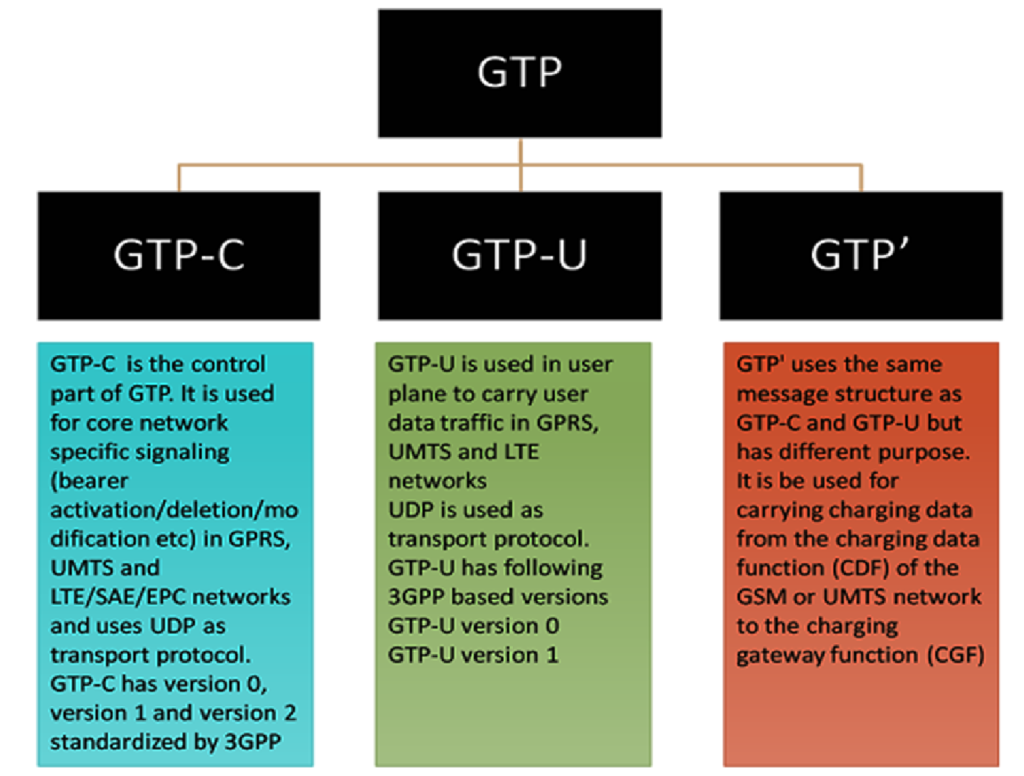
GTP Messages Overview.
GTP messages are used to manage and control connections. These messages fall into two categories:
- Connection-Oriented Messages: These messages come in pairs, such as Create Session Request/Create Session Response, indicating a two-way communication for establishing or modifying a connection.
- Connectionless Unidirectional Messages: These messages, like Modify Bearer Command, are sent in one direction without expecting a direct response.
The naming of GTP messages often indicates who initiates the procedure:
- Mobile-Initiated: When the mobile device requests a connection, the create session procedure is used to activate the default bearer.
- Network-Initiated: When the network initiates a bearer establishment, it uses the create bearer procedure. Similarly, bearer modifications requested by the UE are handled using the modify bearer procedure, while network-requested modifications use the update bearer procedure.
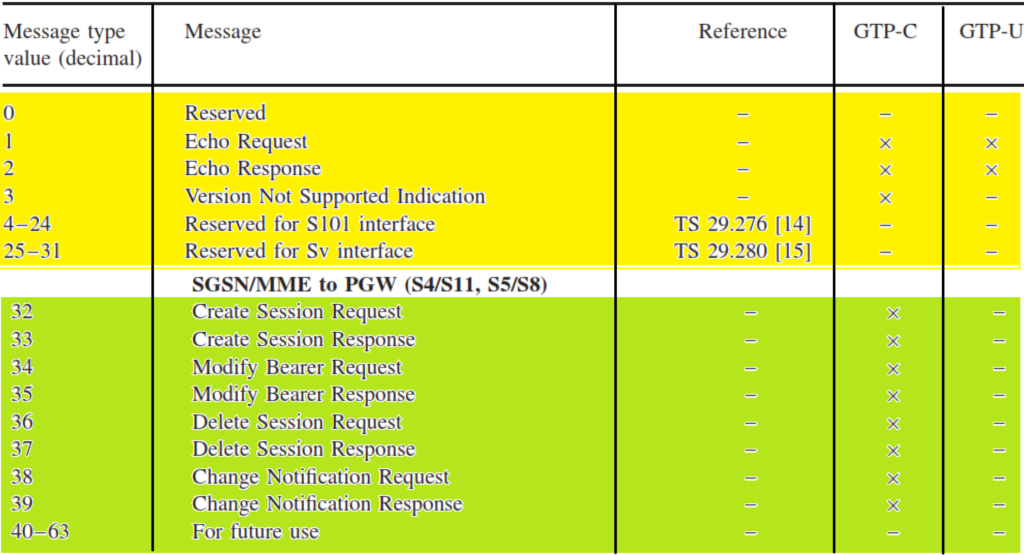
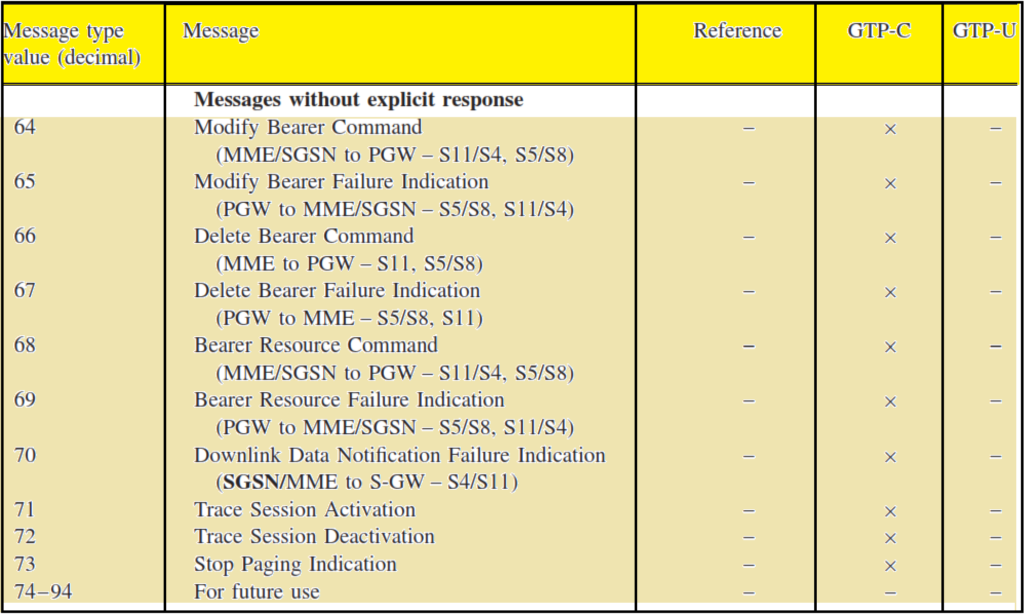
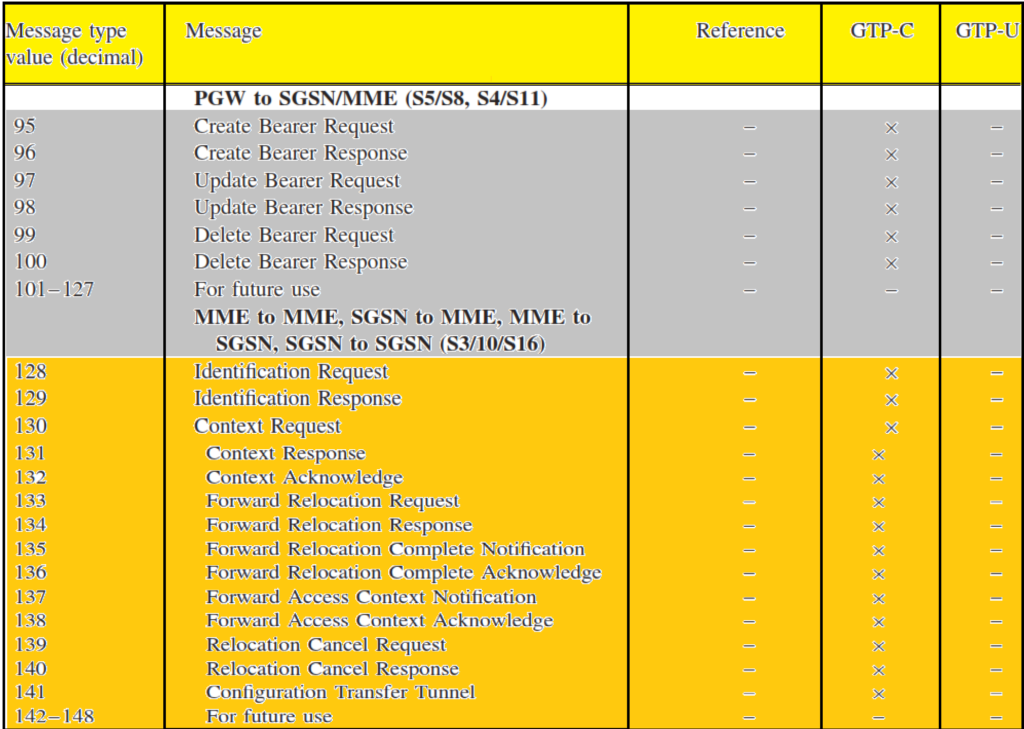
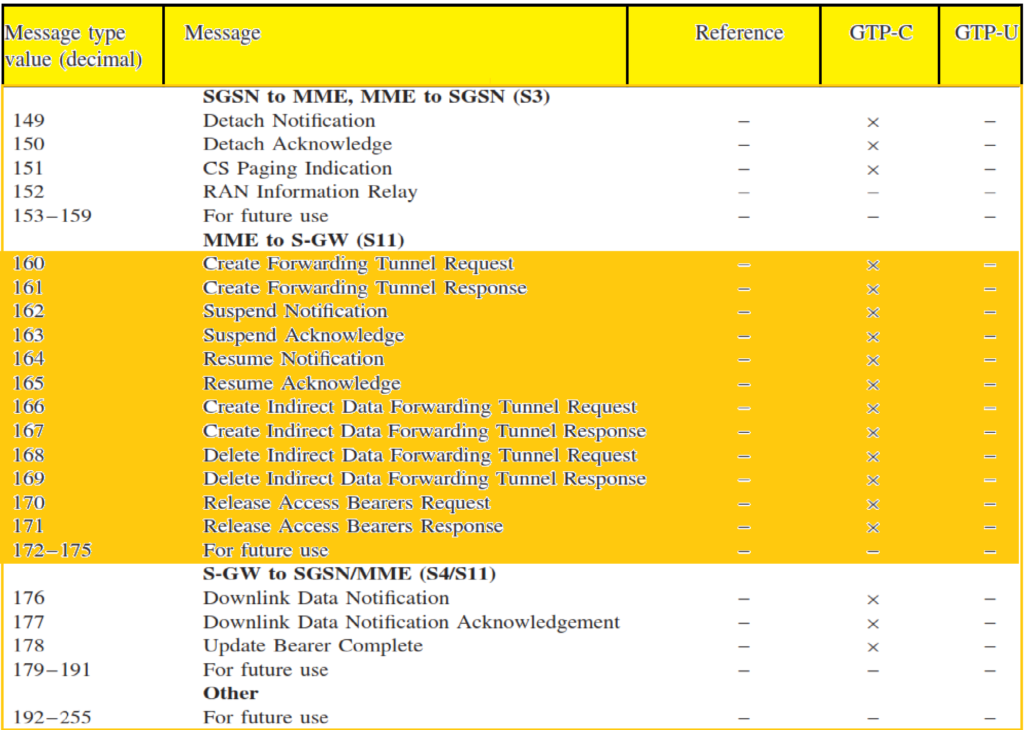
GTP Interfaces in LTE.
In LTE, two versions of the GPRS Tunneling Protocol (GTP) are used to manage control and user plane traffic. Version 2 is employed for GTP-C (Control Plane), while Version 1 is used for GTP-U (User Plane).

GTP-V2 is utilized primarily on two interfaces:
- The S5 Interface, which connects the Serving Gateway (S-GW) and the Packet Data Network Gateway (PDN-GW).
- The S11 Interface, which links the Mobility Management Entity (MME) and the Serving Gateway (S-GW).
GTP-V1 is used on several interfaces for user plane traffic. These include:
- The S1-U Interface, connecting the eNodeB and the Serving Gateway (S-GW) to handle user data.
- The S5 Interface also facilitates user plane traffic between the S-GW and the PDN-GW.
- The X2-U Interface, which connects different eNodeBs for direct user data transfer between them.
In scenarios involving inter-Radio Access Technology (inter-RAT) and inter-Public Land Mobile Network (inter-PLMN) connectivity, several other interfaces utilize GTP protocols. These interfaces include:
- The S3 Interface, which connects the MME to the Serving GPRS Support Node (SGSN) for mobility management.
- The S4 Interface, which links the SGSN and the S-GW to support seamless data transfer and mobility.
- The S8 Interface, used in roaming scenarios to connect the S-GW in the visited network with the PDN-GW in the home network.
- The S10 Interface, which allows MMEs to communicate for MME relocation and handover procedures.
- The S12 Interface, connecting the Radio Network Controller (RNC) and the S-GW.
- The S16 Interface, which facilitates handovers and Serving Radio Network Subsystem (SRNS) relocation between SGSNs.
Advantages and Challenges.
Advantages:
Simplified Protocol Stacks: GTP’s use across various EPC interfaces simplifies the protocol stacks. This reduces the implementation effort for network element protocol software, allowing similar code to be used for programming different network elements like the Serving Gateway (S-GW) and Packet Data Network Gateway (PDN-GW).
Challenges:
Complex Tracking: For companies like Tektronix Communications, simplified protocol stacks make it harder to track messages of a single connection across multiple interfaces. Additional algorithms are needed in software to filter and sequence messages belonging to a single connection and correlate performance measurement counters with different network elements.
1. Path Management.
Path management in the GPRS Tunneling Protocol (GTP) involves using specific messages to verify the activity status of a GTP tunnel through a heartbeat mechanism. The key messages used for this purpose are the GTP Echo Request and GTP Echo Response.
The GTP Echo Request is periodically sent by one entity to check the status of the tunnel. This request includes a sequence number, which the sender expects to see in the response to confirm receipt. The sending of the Echo Request is triggered by a timer and must not occur more frequently than once every 60 seconds for each GTP tunnel. This mechanism ensures that the tunnel is still active and functioning properly.
In response, the GTP Echo Response is sent by the peer entity. This response contains the sequence number from the Echo Request, thereby confirming the tunnel’s activity. This process is crucial for maintaining the integrity and reliability of the GTP tunnels and is depicted in Figure below.
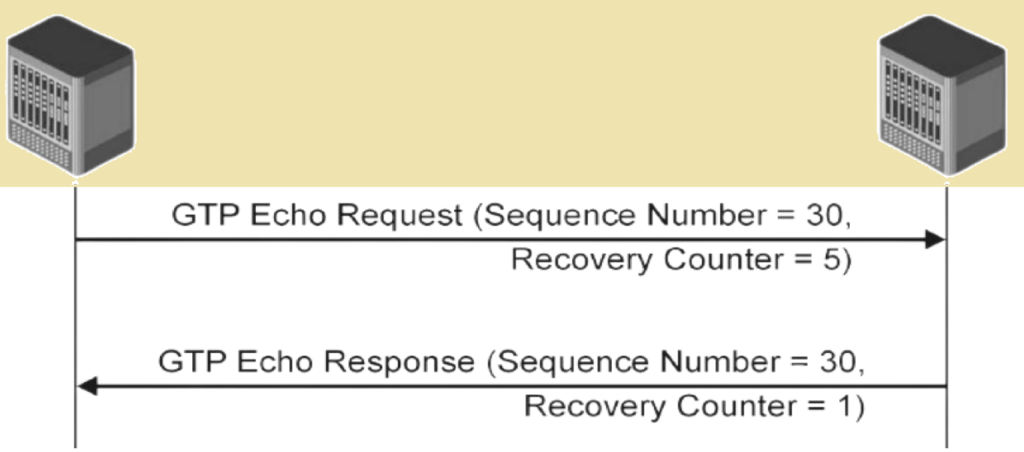
Beyond path management, GTP includes other important functions. Non-3GPP Access ensures interoperability and handover between LTE (E-UTRAN) and other radio access technologies such as CDMA2000 HRDP. This function is essential for providing seamless connectivity across different types of networks.
Trace Management is another critical function within GTP. It involves tracking the activities of selected subscribers, which can be used for network element troubleshooting or legal interception. This trace functionality ensures that network operations can be monitored and maintained effectively, while also complying with legal requirements.
Path management heartbeat messages are utilized on both GTP-C (Control Plane) and GTP-U (User Plane) connections.
2. Tunnel Management in GTP.
Create Session Request.
The create session request message is essential for establishing a session in the Evolved Packet Core (EPC) network. It is sent by the MME to the S-GW on the S11 interface, and by the S-GW to the PDN-GW on the S5/S8 interface during two main procedures:
- E-UTRAN initial attach
- UE requested PDN connectivity.

Additionally, when the S-GW changes due to mobility, the MME sends this request to the new S-GW. The message includes the IMSI as a mandatory element and identifies network elements using Tunnel Endpoint Identifiers (TEIDs). The session activation also involves setting up a default bearer, indicated by the EPS Bearer ID (EBI). The unique combination of IMSI, TEIDs, and EBI helps identify a subscriber’s session or bearer on any GTP-C interface.
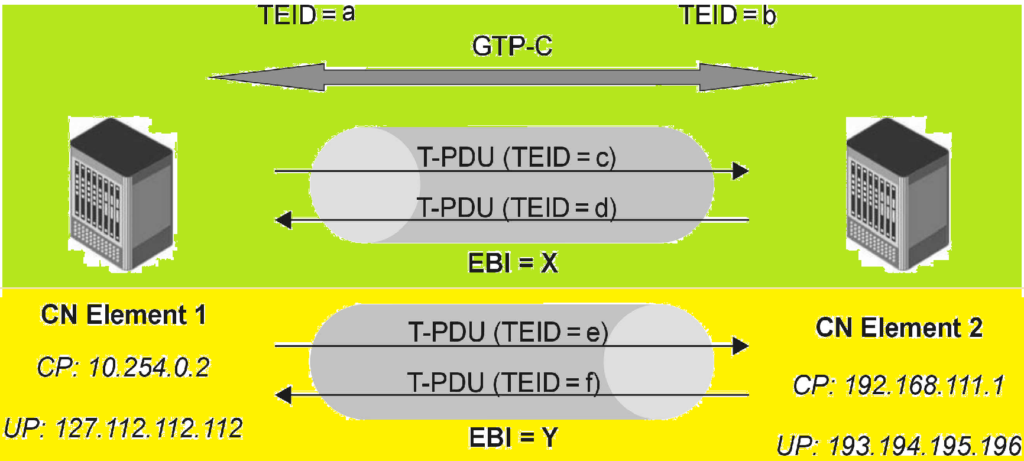
Create Bearer Request
The create bearer request message is used during the dedicated bearer activation procedure. It is sent by the PGW to the S-GW on the S5/S8 interface and by the S-GW to the MME on the S11 interface. This message includes the EBI to link the new bearer with the existing session.
Modify Bearer Request
The modify bearer request message is used to change an established bearer. It is sent on the S11 interface by the MME to the S-GW and on the S5/S8 interfaces by the S-GW to the PDN GW for tracking area updates without changing the S-GW or during a UE-triggered service request.
Delete Bearer Command
The delete bearer command message is sent to release a bearer. This command is initiated by the MME on the S11 interface to the S-GW and by the S-GW to the PGW on the S5/S8 interface. It is part of the procedures for eNB requested bearer release or MME-initiated dedicated bearer deactivation.
Create Indirect Data Forwarding Tunnel Request
The create indirect data forwarding tunnel request message is part of handover procedures. It is sent by the MME or SGSN to the S-GW on the S11/S4 interface.
Release Access Bearers Request
The release access bearers request message is used during the S1 release procedure. It is sent by the MME to the S-GW on the S11 interface and by the SGSN to the S-GW on the S4 interface.
Stop Paging Indication
The stop paging indication message is sent by the S-GW to the MME or SGSN on the S11/S4 interface as part of the network-triggered service request procedure.
Additional Functions
- Path Management: GTP uses Echo Request and Echo Response messages to check tunnel activity status.
- Mobility Management: Ensures seamless handovers between different network types, such as LTE and CDMA2000 HRDP.
- Trace Management: Tracks activities of selected subscribers for network troubleshooting or legal interception.
In conclusion, GTP facilitates efficient management of tunnels, handling sessions, bearers, and ensuring seamless connectivity and mobility across various network interfaces in the EPC.
3. Mobility Management in GTP.
Forward Relocation Request:
When a user equipment (UE) moves from one area to another, a forward relocation request is sent from the source MME to the target MME over the S10 interface. This is part of the S1-based handover relocation procedure. The request can also be sent from the source SGSN to the target MME over the S3 interface during inter-RAT handovers and combined hard handover/SRNS relocation procedures, or from the source SGSN to the target SGSN over the S16 interface for SRNS relocation and PS handover procedures.
Context Request:
The new MME/SGSN sends a context request message to the old MME/SGSN over the S3/S16/S10 interface. This is done during the TAU/RAU procedure to obtain the MM and EPS bearer contexts for the UE. If the UE identifies itself with a temporary identity and has changed SGSN/MME since the last detach, the new MME/SGSN will send an identification request message to the old SGSN/MME over the S3, S16, or S10 interface to request the IMSI.
Forward Access Context Notification:
The old SGSN sends a forward access context notification message to the new SGSN over the S16 interface to forward RNC contexts to the target system. Similarly, the old MME sends this notification to the new MME over the S10 interface to forward RNC/eNB contexts.
Detach Notification:
A detach notification message is sent from an MME to the associated SGSN or vice versa during the detach procedure if ISR (Idle Mode Signaling Reduction) is activated between them. The notification can indicate “Local Detach” or “Complete Detach,” depending on whether the detach is local to the MME/SGSN or if both the MME and SGSN registrations should be detached. “Local Detach” is used in MME/SGSN-initiated detach procedures for implicit detach and HSS-initiated detach procedures, while “Complete Detach” is used in UE-initiated and explicit detach procedures.
Change Notification Request:
The change notification request message is sent on the S4 interface by the SGSN to the S-GW and on the S5/S8 interface by the S-GW to the PGW. This is part of location-dependent charging-related procedures.
Relocation Cancel Request:
A relocation cancel request is sent from the source MME/SGSN to the target MME/SGSN on the S3/S10/S16 interface during inter-RAT handover cancel procedures and on the S16 interface for SRNS relocation cancel procedures. Relocation cancellation typically occurs if a relocation timer expires or if the UE cannot hand over on the radio interface due to software defects or incorrect radio interface parameters.
Configuration Transfer Tunnel:
The configuration transfer tunnel message is used to tunnel eNB configuration transfer messages from a source MME to a target MME over the S10 interface. This allows eNBs to exchange important information, such as UL interference status, even if they are not physically connected using the X2 interface.
RAN Information Relay:
The RAN information relay message is sent on the S3 interface between the SGSN and MME. It transfers RAN information received by an SGSN from BSS or RNS (GERAN Iu mode) or by an MME from eNB.
4. CS Fallback.
CS fallback is used to route voice call service requests from LTE/EPC to UMTS/GSM networks. This allows network operators with both GSM/UMTS and 4G networks to optimize resource usage. They can reserve the high-speed packet-switched (PS) capabilities of LTE and EPC for data traffic, while voice calls are managed by the reliable legacy GSM and UMTS networks. The GTP messages play a key role in supporting this functionality.
Suspend Notification:
When a voice call needs to switch from LTE to UMTS/GSM, a suspend notification message is sent on the S11 interface from the MME to the S-GW. This message is part of the CS fallback procedure from E-UTRAN to UTRAN/GERAN CS domain access. The suspend notification pauses the call temporarily to allow the signaling connection to switch from 4G to UMTS/GSM. The receiving entity replies with a suspend acknowledge message.
Resume Notification:
After the fallback, when the call returns to the LTE network, a resume notification message is sent on the S11 interface from the MME to the S-GW. This message resumes the previously suspended call, bringing it back into service. The receiving entity responds with a resume acknowledge message.
CS Paging Indication:
If a UE was redirected to UTRAN/GERAN for CS services due to fallback, but still receives paging over the EPS, a CS paging indication is sent on the S3 interface by the MME to the associated SGSN. This occurs when ISR (Idle Mode Signaling Reduction) is activated, as part of the mobile-terminated CS services.
5. Non-3GPP-Related Access.
Messages for non-3GPP-related access are crucial for supporting mobility between E-UTRAN (LTE) and CDMA2000 radio access networks.
During an active handover from E-UTRAN to CDMA2000 HRPD, an MME sends a create forwarding tunnel request message to the S-GW. This message is part of the MME’s configuration resources for indirect data forwarding. The S-GW responds with a create forwarding tunnel response message.
6. Trace Management.
To activate a trace session for a specific IMSI or IMEI, the trace session activation message is sent on the S11 interface by the MME to the S-GW, and on the S5/S8 interfaces by the S-GW to the PGW. This is done for both attached and active or attached and idle UEs.
To deactivate a trace session for a specific subscriber, the trace session deactivation message is sent on the S11 interface by the MME to the S-GW, and on the S5/S8 interfaces by the S-GW to the PGW. This applies to both attached and active or attached and idle UEs.
The data report for the trace functionality has a proprietary structure defined by individual network equipment manufacturers (NEMs).
Full Course on LTE RF Optimization (Explained by telecommunication industry experts).